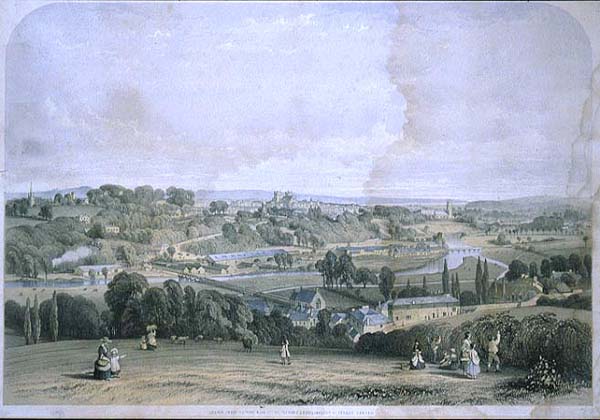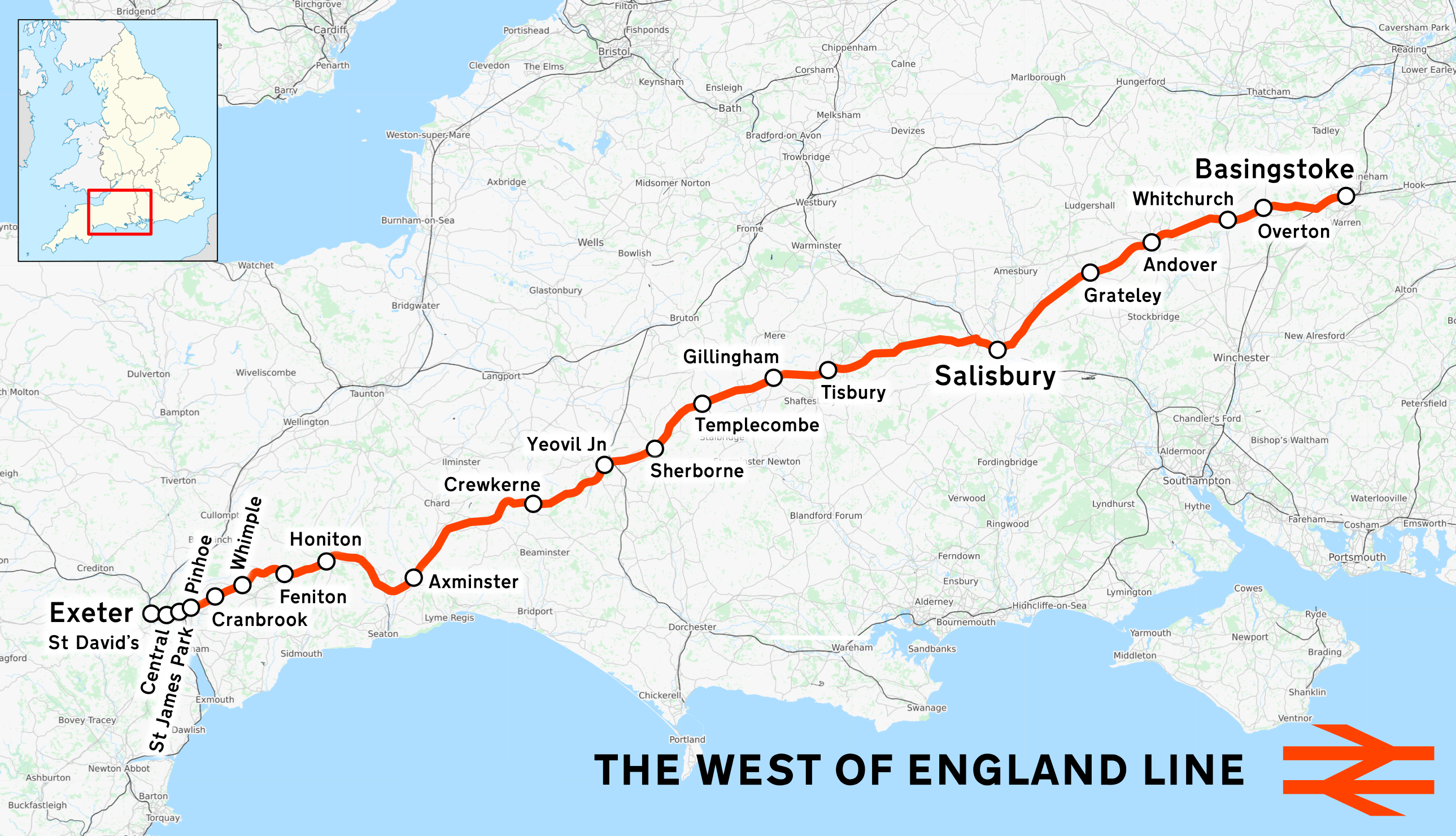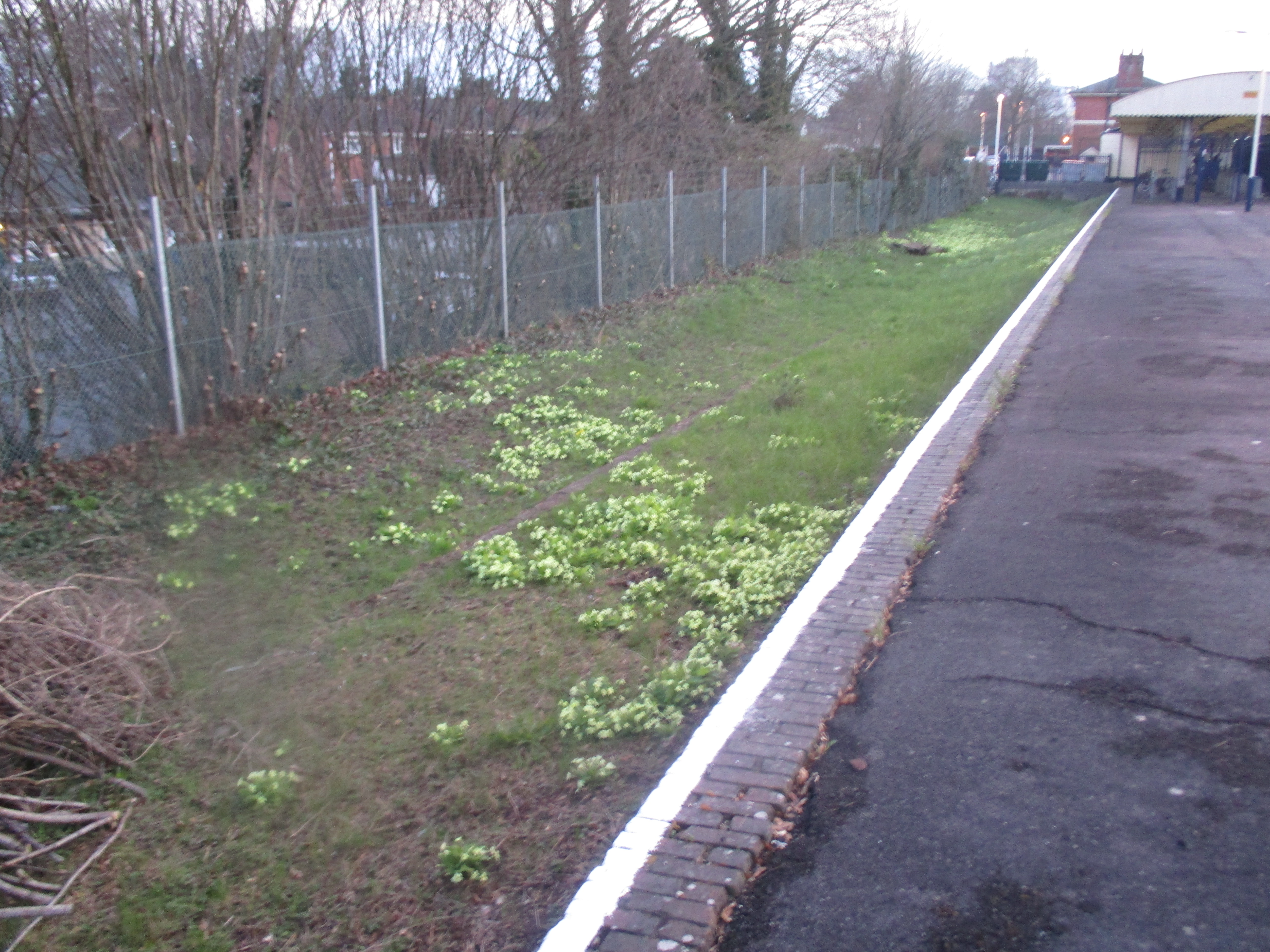|
Grateley Railway Station
Grateley railway station serves the village of Grateley, Hampshire, England, and the surrounding countryside. It is down the line from . It is operated by South Western Railway. The station opened on 1 May 1857. It was built southwest of Grateley village, near the hamlet of Palestine, after the local landowner objected to it being built any closer. Since then, a new settlement has grown up around the station. On 5 June 1861, the Grateley station master was killed as a result of a driver and guard rushing to move freight wagons. The station has few facilities and is unmanned. There is a self-service ticket machine on platform 1 and smartcard readers on both platforms. There are two car parks for the large number of commuters who use the station. Displays on each platform show the next two trains. All trains are operated by South Western Railway. Services South Western Railway operates an hourly service between London Waterloo and Salisbury with limited extensions to Bristol ... [...More Info...] [...Related Items...] OR: [Wikipedia] [Google] [Baidu] |
Grateley
Grateley is a village and civil parish in the north west of Hampshire, England. The name is derived from the Old English ''grēat lēah'', meaning 'great wood or clearing'. The village is divided into two distinct settlements, apart: the old village and a newer settlement built around the railway station on the West of England Main Line. The hamlet of Palestine adjoins the railway station settlement, although it is located in the civil parish of Over Wallop. Grateley lies just to the south of the prehistoric hill fort of Quarley Hill. The parish covers with 616 people living in 250 dwellings. The village has one pub, a thirteenth-century church dedicated to St Leonard, a primary school, a school for children with Asperger syndrome, a railway station, a small business park, a golf driving range, and is surrounded by farmland with ancient footpaths and droveways. King Æthelstan issued his first official law code in Grateley in about 930 AD. Recorded in the early 12th centur ... [...More Info...] [...Related Items...] OR: [Wikipedia] [Google] [Baidu] |
Exeter St Davids Railway Station
Exeter St Davids is the principal railway station serving the city of Exeter in Devon, England. It is from the zero point at on the line through Bristol which continues to Plymouth and Penzance. It is also served by an alternative route to London Waterloo via Salisbury and branch lines to Exmouth, Barnstaple, and Okehampton. It is currently managed by Great Western Railway and is served by trains operated by Great Western Railway, South Western Railway and CrossCountry. History The station was opened on 1 May 1844 by the Bristol and Exeter Railway (B&ER). The station was designed by Isambard Kingdom Brunel and was one of his single-sided stations which meant that the two platforms were both on the east side of the line. This was the side nearer the town and so very convenient for passengers travelling into Exeter but did mean that a lot of trains had to cross in front of others. This was not too much of a problem while the station was at the end of the line, but on 30 M ... [...More Info...] [...Related Items...] OR: [Wikipedia] [Google] [Baidu] |
Railway Stations In Great Britain Opened In 1857
Rail transport (also known as train transport) is a means of transport that transfers passengers and goods on wheeled vehicles running on rails, which are incorporated in Track (rail transport), tracks. In contrast to road transport, where the vehicles run on a prepared flat surface, rail vehicles (rolling stock) are directionally guided by the tracks on which they run. Tracks usually consist of steel rails, installed on Railroad tie, sleepers (ties) set in track ballast, ballast, on which the rolling stock, usually fitted with metal wheels, moves. Other variations are also possible, such as "slab track", in which the rails are fastened to a concrete foundation resting on a prepared subsurface. Rolling stock in a rail transport system generally encounters lower friction, frictional resistance than rubber-tyred road vehicles, so passenger and freight cars (carriages and wagons) can be coupled into longer trains. The rail transport operations, operation is carried out by a ... [...More Info...] [...Related Items...] OR: [Wikipedia] [Google] [Baidu] |
Former London And South Western Railway Stations
A former is an object, such as a template, gauge or cutting die, which is used to form something such as a boat's hull. Typically, a former gives shape to a structure that may have complex curvature. A former may become an integral part of the finished structure, as in an aircraft fuselage, or it may be removable, being using in the construction process and then discarded or re-used. Aircraft formers Formers are used in the construction of aircraft fuselage, of which a typical fuselage has a series from the nose to the empennage, typically perpendicular to the longitudinal axis of the aircraft. The primary purpose of formers is to establish the shape of the fuselage and reduce the column length of stringers to prevent instability. Formers are typically attached to longerons, which support the skin of the aircraft. The "former-and-longeron" technique (also called stations and stringers) was adopted from boat construction, and was typical of light aircraft built until the ad ... [...More Info...] [...Related Items...] OR: [Wikipedia] [Google] [Baidu] |
DfT Category F1 Stations
The Department for Transport (DfT) is a department of His Majesty's Government responsible for the English transport network and a limited number of transport matters in Scotland, Wales and Northern Ireland that have not been devolved. The department is run by the Secretary of State for Transport, currently (since 25 October 2022) Mark Harper. The expenditure, administration and policy of the Department for Transport are scrutinised by the Transport Committee. History The Ministry of Transport was established by the Ministry of Transport Act 1919 which provided for the transfer to the new ministry of powers and duties of any government department in respect of railways, light railways, tramways, canals and inland waterways, roads, bridges and ferries, and vehicles and traffic thereon, harbours, docks and piers. In September 1919, all the powers of the Road Board, the Ministry of Health, and the Board of Trade in respect of transport, were transferred to the new ministry. ... [...More Info...] [...Related Items...] OR: [Wikipedia] [Google] [Baidu] |
Railway Stations In Hampshire
Rail transport (also known as train transport) is a means of transport that transfers passengers and goods on wheeled vehicles running on rails, which are incorporated in tracks. In contrast to road transport, where the vehicles run on a prepared flat surface, rail vehicles (rolling stock) are directionally guided by the tracks on which they run. Tracks usually consist of steel rails, installed on sleepers (ties) set in ballast, on which the rolling stock, usually fitted with metal wheels, moves. Other variations are also possible, such as "slab track", in which the rails are fastened to a concrete foundation resting on a prepared subsurface. Rolling stock in a rail transport system generally encounters lower frictional resistance than rubber-tyred road vehicles, so passenger and freight cars (carriages and wagons) can be coupled into longer trains. The operation is carried out by a railway company, providing transport between train stations or freight customer facilit ... [...More Info...] [...Related Items...] OR: [Wikipedia] [Google] [Baidu] |
West Of England Main Line
The West of England line (also known as the West of England Main Line) is a British railway line from , Hampshire, to in Devon, England. Passenger services run between London Waterloo station and Exeter; the line intersects with the Wessex Main Line at . Despite its historic title, it is not today's principal route from London to the West of England: Exeter and everywhere further west are reached more quickly from London Paddington via the Reading–Taunton line. History Once all sections had been incorporated into the London and South Western Railway, the sections and branches were: * Basingstoke to Salisbury ** Basingstoke to Andover, opened 3 July 1854 ** Andover to Salisbury, opened 1 May 1857 ** Branches: ***''Basingstoke and Alton Light Railway'' opened June 1901, closed 30 May 1936 *** From Hurstbourne and Andover to Romsey and on to Eastleigh and Southampton: both closed. Link via Longparish opened 1 June 1885; closed 6 July 1931. *** At Andover, junction with the ... [...More Info...] [...Related Items...] OR: [Wikipedia] [Google] [Baidu] |
Andover Railway Station (England)
Andover railway station serves the town of Andover, Hampshire, England. The station is served and operated by South Western Railway. It is down the line from on the West of England Main Line. According to the Office of Rail Regulation statistics on rail trends for the year 2019-20, 1,152,576 exits and entries were made at Andover rail station, making it the 15th most used rail station in the county of Hampshire (including the unitary authority areas of Portsmouth City Council and Southampton City Council). History The station was opened on 3 July 1854 and was previously known as Andover Junction, as it stood at the junction of the Exeter-London line and the now-defunct Midland and South Western Junction Railway running between Cheltenham, Swindon, Andover and Southampton Terminus.Body, p.54 Andover had a second station, Andover Town, to the south of the junction station on the line to Redbridge that was often called the Sprat and Winkle Line. This route fell victim to ... [...More Info...] [...Related Items...] OR: [Wikipedia] [Google] [Baidu] |
Weymouth Railway Station
Weymouth railway station is the main railway station serving the town of Weymouth, Dorset, England (the other being Upwey station which is located north of the town centre). The station is the southern terminus of both the South West Main Line, down the line from , and the Heart of Wessex Line from and , from . History The Wilts, Somerset and Weymouth Railway, which was authorised in 1845, was built in stages (during which the company was absorbed in 1850 by the Great Western Railway). Two of the last sections, from to Weymouth and a connecting curve from that line to the Dorchester station of the London and South Western Railway (LSWR), were opened on 20 January 1857. The LSWR was granted running powers from Dorchester to Weymouth, where some of the platforms were dedicated for LSWR use; these powers were exercised from the opening day. The station was named ''Weymouth'', although some timetables showed it as ''Weymouth Town''. Branches to Portland and Weymouth Quay (both ... [...More Info...] [...Related Items...] OR: [Wikipedia] [Google] [Baidu] |
Yeovil Pen Mill Railway Station
Yeovil Pen Mill railway station is one of two stations serving the town of Yeovil, Somerset, England. The station is situated just under a mile to the east of the town centre. The station is located south of , on the Heart of Wessex Line. The station is managed by Great Western Railway, with trains being operated by them and by South Western Railway. History The station was opened by the Great Western Railway (GWR) as part of the Wilts, Somerset and Weymouth route on 1 September 1856. The route was completed to on 20 January 1857. The Bristol and Exeter Railway's (B&ER) line from Taunton, which initially terminated at , was extended to connect with the GWR at Yeovil Pen Mill from 2 February 1857. Both these lines were built using the broad gauge. The GWR line was converted to what become the standard gauge in June 1874. The B&ER line was mixed and had trains of both gauges from 12 November 1868 but broad gauge trains ceased operation after 30 June 1879 by which time th ... [...More Info...] [...Related Items...] OR: [Wikipedia] [Google] [Baidu] |
Bristol Temple Meads Railway Station
Bristol Temple Meads is the oldest and largest railway station in Bristol, England. It is located away from London Paddington. It is an important transport hub for public transport in the city; there are bus services to many parts of the city and surrounding districts, with a ferry to the city centre. Bristol's other major station, Bristol Parkway, is a more recent station on the northern outskirts of the conurbation. Temple Meads was opened on 31 August 1840, as the western terminus of the Great Western Railway. The railway, including Temple Meads, was the first to be designed by the British engineer Isambard Kingdom Brunel. Soon, the station was also used by the Bristol and Exeter Railway, the Bristol and Gloucester Railway, the Bristol Harbour Railway and the Bristol and South Wales Union Railway. To accommodate the increasing number of trains, the station was expanded in the 1870s by Francis Fox and again between 1930 and 1935 by Percy Emerson Culverhouse. Brunel's termi ... [...More Info...] [...Related Items...] OR: [Wikipedia] [Google] [Baidu] |
Test Valley
Test Valley is a local government district and borough in Hampshire, England, named after the valley of the River Test. Its council is based in Andover. The borough was formed on 1 April 1974 by a merger of the boroughs of Andover and Romsey, along with Andover Rural District and Romsey and Stockbridge Rural District. Location Test Valley covers some of western Hampshire, stretching from boundaries with Southampton in the south to Newbury in the north. Test Valley is a predominantly rural area. It encompasses the North Wessex Downs Area of Outstanding Natural Beauty. The River Test is the centrepiece of the Test Valley; the river is a chalk stream of particular beauty known for its fishing, salmon and trout, which Lord Crickhowell (onetime chairman of the National Rivers Authority) said "should be treated as a great work of art or music". Home of the Houghton Fishing Club, an exclusive fishing club founded in 1822, which meets in the Grosvenor Hotel in Stockbridge. Demograp ... [...More Info...] [...Related Items...] OR: [Wikipedia] [Google] [Baidu] |





_Station%2C_with_an_express_to_Waterloo_geograph-2635809-by-Ben-Brooksbank.jpg)

